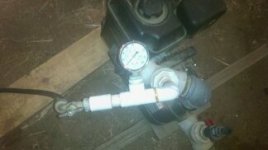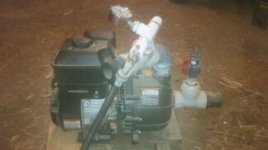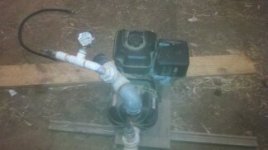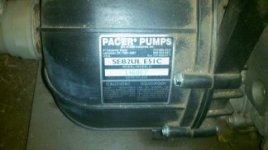Here are the pictures of my irrigation pump. It's the Pacer 2" Econo Series that pumps up to 200 gpm @ up to 52psi.
Picture 145 is of the outlet side of the pump. I plumbed in a t- and reduce one side down to a garden hose spicket. That way every time I start pumping water I can fill up my primer jug with water. The pump takes about 2 gallons to prime and I keep a couple full milk jugs by the pump. If it has lost it's prime, I just pour the water in the pump, crank it, and then refill my jugs. That way I don't have to carry water or wade down into the pond to fill my jugs (yeah I'm lazy

). I also have a guage (liquid filled) to set the output pressure. I recommend buying guages from AgriSupply. Item # 16518 is only $6.99. They are over $20.00 locally. I keep 2 or 3 on hand. I tried a regular guage, but the needle jumped around soo bad you couldn't read it.
Picture 146 is a side view. You can see that I also have a T plumbed in on the inlet side. If I want to use liquid fertilizer and inject at the roots I do the following:
1. Get a 55 gallon drum
2. Pump it full of water out of the pond and mix in my bag of water solulable fertilizer.
3. Connect a hose from the pump and drop it in the drum. I use a 3/4" clear hose, so you can see the water flow through it.
4. Get all the lines in the field pressurized and flush them out. When I get the pressure on the pump set (regulated) I open the valve on the inlet side of the pump. It will draw the fertilze out of the 55 gallon drum into all the lines burried in the field.
IMPORTANT: I barely open the line as it will suck all the drum dry in a couple minutes if you don't. I usually try to inject the fertilize over about 10 minutes so that it will evenly be distributed through the field.
I also use this setup about once a week to pump amonia or Clorox (Walmart Clorox works good) through the lines in the same way. I delute the amonia or Clorox with water and then slowly pump it through the lines. This kills any bacteria or algae growing in the lines. I've never had a problem with the t-tape stopping up doing this. All the "big time" tomatoe farmers around me do it the same way. They do not run a filter on their pumps and they are using 1000GPM PTO pumps and tractors to pump water.
Picture 147 is a top view of the pump. I attached a 2x3 (pallet strap) to the bottom of the pump to keep it from vibrating into the ground on the inlet side.
Picture 148 is self explanitory.
Another important thing to do is plumb in a cutoff valve (in your layflat hose) about 6' from the pump (outlet side). These pumps need some backpressure to begin drafting water. I cut off the valve and crank the pump. When I hear the motor start pulling down (drafting) and see the guage start to rise, I open the valve slowly and the pump will catch on. This also allows me to cut off the valve when I have finished irrigating for the day. If you don't cut off the valve the water will flow back out of the lines into the pond. The producers of t-tape tell you to use a backflow preventer, but the one that I bought had too much restriction and I just use the cut off valve. You can get a 2" PVC valve for about $12.00. If you don't keep the lines from backflowing they will suck mud into the t-tape and stop up the outlets.
Any questions, just ask away.




